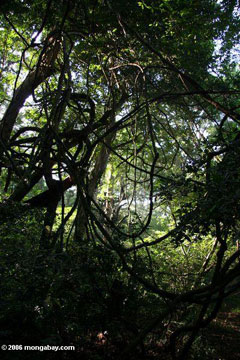New monkey species in Uganda
New monkey species in Uganda
mongabay.com
February 19, 2007
Uganda may soon have a new species of monkey according to a report published in Kampala’s New Vision newspaper.
Dr. Colin Groves of the Australian National University told New Vision that the local population of the gray-cheeked mangabey (Lophocebus albigena) will soon be designated as a unique species, the Ugandan gray-cheeked mangabey (Lophocebus ugandae).
The decision is based on “new methods of analysis” that distinguish the monkey population from gray-cheeked mangabey living in Rwanda, Burundi and DR Congo (DRC).
“My taxonomic revision is based on new analyses, mainly multivariate analysis of skull measurements,” Dr. Groves said in an email exchange with mongabay.com. “Multivariate analyses showed clearly that there is a sharp separation between Lophocebus in Uganda and those in DRC. At the same time, I intend to upgrade the other putative subspecies of Lophocebus albigena to species level (osmani, johnstoni). This makes, with aterrimus and opdenboschi, six species in the genus, and with the recently described kipunji, seven (as many as there are in the other mangabey genus, Cercocebus).”
 Rainforest in Uganda. Photo by Rhett A. Butler. More Uganda photos. |
The timing of the decision is noteworthy as the species’ habitat has recently been targeted for clearing. Against the wishes of the National Forest Authority (NFA), Ugandan president Yoweri Museveni granted a 7,000 hectare concession in Mabira forest, a reserve since 1932, to the owners of a Uganda-based sugar firm. Museveni’s decision was widely criticized by conservationists, parliament, and citizens of Uganda who said the sugar plantation would damage the tourism industry and impact local water supplies.
Dr. Groves said that his work has new urgency given the threat to Mariba.
“I presented the analyses in the International Primatological Society Congress in Entebbe last year,” said Dr. Groves. “I had not thought it a priority to publish it — I have so many other things to be getting on with — but now the threat to Mabira Forest has emerged, and this makes it more urgent. Although L. ugandae is widespread in the western and lakeshore forests of Uganda, it is apparently very abundant in Mabira, and the loss of this population would probably mean the loss of about a quarter of the total population of what now turns out to be an endemic species.”
Lophocebus ugandae would be Uganda’s its first endemic species of primate and its 19th primate species overall. It would likely be added to the IUCN Red List of threatened species.
Related articles
President Museveni needs to do what’s best for Uganda — 12/14/2006
In recent months Ugandan president Yoweri Museveni has moved to destroy some of Uganda’s last remaining primary rainforests to give land to politically-connected plantation owners. Personally intervening in two disputes, one in Mabira Forest Reserve and the other on Bugala island in Lake Victoria, Museveni has argued that his country urgently needs such projects to industrialize and bring a better quality of life to Ugandans. He would be wrong.